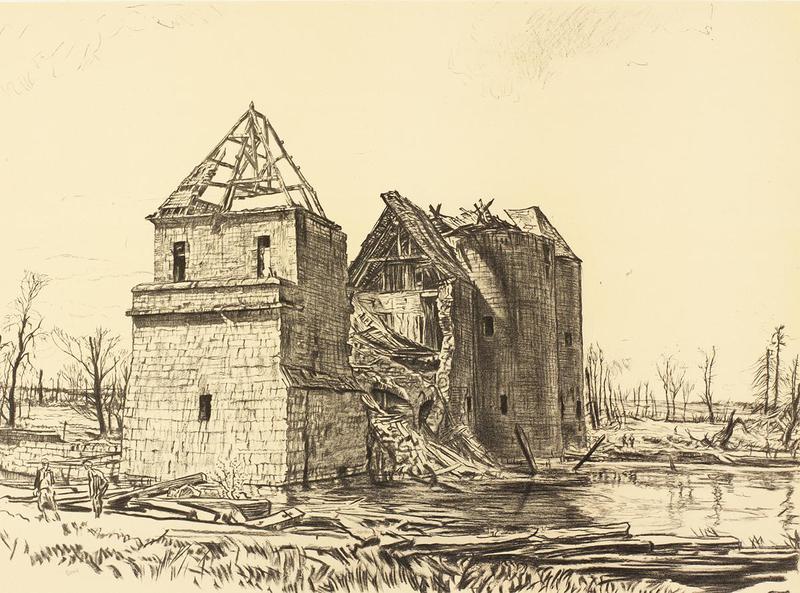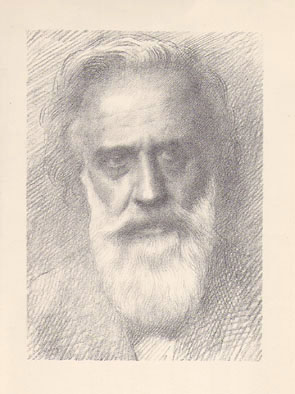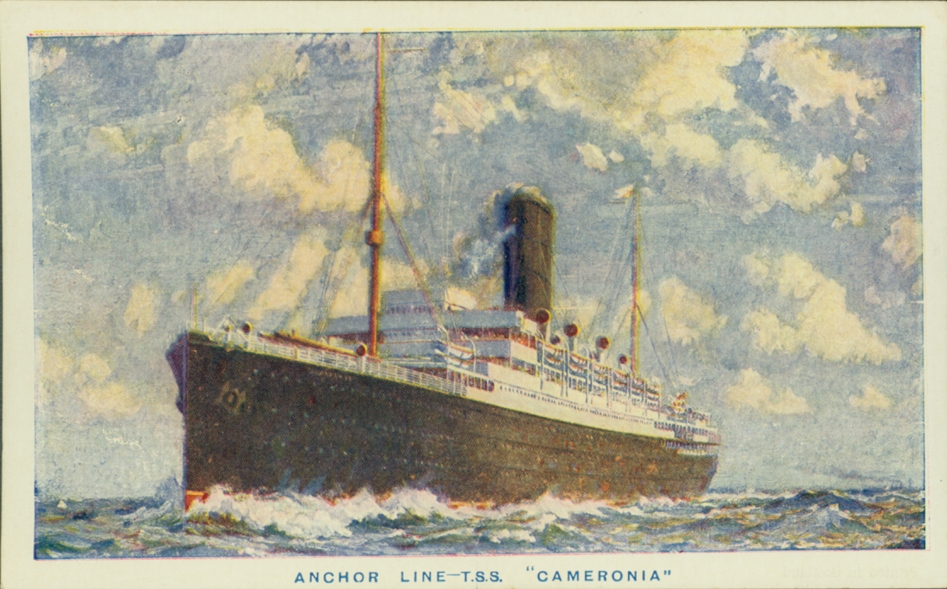|
Muirhead Bone
Sir Muirhead Bone (23 March 1876 – 21 October 1953) was a Scottish etcher and watercolourist who became known for his depiction of industrial and architectural subjects and his work as a war artist in both the First and Second World Wars. A figure in the last generation of the Etching Revival, Bone's early large and heavily-worked architectural subjects fetched extremely high prices before the Wall Street Crash of 1929 deflated the collectors' market. He was well known, if not notorious, for publishing large numbers of different states of etchings, encouraging collectors to buy several impressions. Bone was an active member of both the British War Memorials Committee in the First World War and the War Artists' Advisory Committee in the Second World War. He promoted the work of many young artists and served as a Trustee of the Tate Gallery, the National Gallery, and the Imperial War Museum. Early life Muirhead Bone was born in Partick, Glasgow. His parents were journalist Dav ... [...More Info...] [...Related Items...] OR: [Wikipedia] [Google] [Baidu] |
Battle Of The Somme
The Battle of the Somme ( French: Bataille de la Somme), also known as the Somme offensive, was a battle of the First World War fought by the armies of the British Empire and French Third Republic against the German Empire. It took place between 1 July and 18 November 1916 on both sides of the upper reaches of the Somme, a river in France. The battle was intended to hasten a victory for the Allies. More than three million men fought in the battle of whom one million were wounded or killed, making it one of the deadliest battles in human history. The French and British had committed themselves to an offensive on the Somme during the Chantilly Conference in December 1915. The Allies agreed upon a strategy of combined offensives against the Central Powers in 1916 by the French, Russian, British and Italian armies, with the Somme offensive as the Franco-British contribution. Initial plans called for the French army to undertake the main part of the Somme offensive, supported on ... [...More Info...] [...Related Items...] OR: [Wikipedia] [Google] [Baidu] |
Alphonse Legros
Alphonse Legros (8 May 1837 – 8 December 1911) was a French, later British, painter, etcher, sculptor, and medallist. He moved to London in 1863 and later took British citizenship. He was important as a teacher in the British etching revival. Life Legros was born in Dijon; his father was an accountant, and came from the neighbouring village of Véronnes. While young, Legros visited the farms of his relatives, and the peasants and landscapes of that part of France are the subjects of many of his works. He was sent to the art school at Dijon with a view to qualifying for a trade, and was apprenticed to Maître Nicolardo, house decorator and painter of images. In 1851, Legros left for Paris to take another situation; but passing through Lyon he worked for six months as journeyman wall-painter under the decorator Beuchot, who was painting the chapel of Cardinal Bonald in the cathedral. In Paris, Legros studied with Charles-Antoine Cambon, scene-painter and decorator of the ... [...More Info...] [...Related Items...] OR: [Wikipedia] [Google] [Baidu] |
Dugald MacColl
Dugald Sutherland MacColl (10 March 1859 – 21 December 1948) was a Scottish watercolour painter, art critic, lecturer and writer. He was keeper of the Tate Gallery for five years. Life MacColl was born in Glasgow and educated at the University of London and the University of Oxford between 1876 and 1884. He also studied at the Westminster School of Art and the Slade School under Alphonse Legros between 1884 and 1892. Although an accomplished watercolourist, he is best remembered as a writer and lecturer on art. From 1890 to 1895 he was art critic for ''The Spectator'', and for the '' Saturday Review'' from 1896 to 1906. MacColl became a member of the New English Art Club in 1896, and edited the ''Architectural Review'' from 1901 to 1905. He published the authoritative book, ''Nineteenth Century Art'', in 190and his biography ''Philip Wilson Steer'' was awarded the 1945 James Tait Black Memorial Prize. In his journalism and books he was a major advocate of the French Impr ... [...More Info...] [...Related Items...] OR: [Wikipedia] [Google] [Baidu] |
William Strang
William Strang (13 February 1859 – 12 April 1921) was a Scottish painter and printmaker, notable for illustrating the works of Bunyan, Coleridge and Kipling. Early life Strang was born at Dumbarton, the son of Peter Strang, a builder, and was educated at the Dumbarton Academy. For fifteen months after leaving school he worked in the counting-house of a firm of shipbuilders, then in 1875, when he was sixteen, went to London. There he studied art under Alphonse Legros at the Slade School for six years. Strang had great success as an etcher and became assistant master in the etching class. He was one of the founding members of the Royal Society of Painter-Etchers, and his work was part of its first exhibition in 1881. Some of his early plates were published in '' The Portfolio'' and other art magazines. Work He worked in many techniques: etching, drypoint, mezzotint, sand-ground mezzotint, burin engraving, lithography and woodcut. He cut a large wood engraving of a man plo ... [...More Info...] [...Related Items...] OR: [Wikipedia] [Google] [Baidu] |
British Museum
The British Museum is a public museum dedicated to human history, art and culture located in the Bloomsbury area of London. Its permanent collection of eight million works is among the largest and most comprehensive in existence. It documents the story of human culture from its beginnings to the present.Among the national museums in London, sculpture and decorative and applied art are in the Victoria and Albert Museum; the British Museum houses earlier art, non-Western art, prints and drawings. The National Gallery holds the national collection of Western European art to about 1900, while art of the 20th century on is at Tate Modern. Tate Britain holds British Art from 1500 onwards. Books, manuscripts and many works on paper are in the British Library. There are significant overlaps between the coverage of the various collections. The British Museum was the first public national museum to cover all fields of knowledge. The museum was established in 1753, largely b ... [...More Info...] [...Related Items...] OR: [Wikipedia] [Google] [Baidu] |
Lithography
Lithography () is a planographic method of printing originally based on the immiscibility of oil and water. The printing is from a stone (lithographic limestone) or a metal plate with a smooth surface. It was invented in 1796 by the German author and actor Alois Senefelder and was initially used mostly for musical scores and maps.Meggs, Philip B. A History of Graphic Design. (1998) John Wiley & Sons, Inc. p 146 Carter, Rob, Ben Day, Philip Meggs. Typographic Design: Form and Communication, Third Edition. (2002) John Wiley & Sons, Inc. p 11 Lithography can be used to print text or images onto paper or other suitable material. A lithograph is something printed by lithography, but this term is only used for fine art prints and some other, mostly older, types of printed matter, not for those made by modern commercial lithography. Originally, the image to be printed was drawn with a greasy substance, such as oil, fat, or wax onto the surface of a smooth and flat limestone plat ... [...More Info...] [...Related Items...] OR: [Wikipedia] [Google] [Baidu] |
Printmaking
Printmaking is the process of creating artworks by printing, normally on paper, but also on fabric, wood, metal, and other surfaces. "Traditional printmaking" normally covers only the process of creating prints using a hand processed technique, rather than a photographic reproduction of a visual artwork which would be printed using an electronic machine ( a printer); however, there is some cross-over between traditional and digital printmaking, including risograph. Except in the case of monotyping, all printmaking processes have the capacity to produce identical multiples of the same artwork, which is called a print. Each print produced is considered an "original" work of art, and is correctly referred to as an "impression", not a "copy" (that means a different print copying the first, common in early printmaking). However, impressions can vary considerably, whether intentionally or not. Master printmakers are technicians who are capable of printing identical "impressions" by ... [...More Info...] [...Related Items...] OR: [Wikipedia] [Google] [Baidu] |
Gertrude Helena Dodd
Gertrude Helena Bone, Lady Bone ( Dodd; 1876–1962) was a British writer who published during the Edwardian era. She wrote short stories, three novels, and several illustrated collections. Life Gertrude Dodd was the daughter of the Methodist minister Benjamin Dodd, and younger sister to the artist Francis Dodd. She was raised in Glasgow, where her brother attended Garnett Hill School and met Muirhead Bone, her future husband. Gertrude and Muirhead became engaged in 1898, but could not afford to marry until five years later, when he published his first portfolio of drawings. They married in 1903 and moved to Thamescote, Chiswick. Their first son, Stephen Bone, was born the next year on 13 November 1904 in Chiswick. A second son, Gavin Bone, was born in 1907. Gertrude Bone, like her father, was a "staunch Methodist": Stephen Bone remembered his childhood as one in which "presents, entertaining, and alcohol were banished; pencil and paper for drawing were deemed sufficient d ... [...More Info...] [...Related Items...] OR: [Wikipedia] [Google] [Baidu] |
Francis Dodd (artist)
Francis Edgar Dodd (29 November 1874 – 7 March 1949) was a British portrait painter, landscape artist and printmaker. Biography Dodd was born in Holyhead, Anglesey, Wales, the son of a Wesleyan minister. He trained at the Glasgow School of Art alongside Muirhead Bone, who married Dodd's sister, Gertrude. At Glasgow, Dodd won the Haldane Scholarship in 1893 and then travelled around France, Italy and later Spain. Dodd returned to England in 1895 and settled in Manchester, becoming friends with Charles Holden, before moving to Blackheath in London in 1904. During World War I, in 1916, he was appointed an official war artist by Charles Masterman, the head of the War Propaganda Bureau, WPB. Serving on the Western Front, he produced more than 30 portraits of senior military figures. However, he also earned a considerable peacetime reputation for the quality of his watercolours and portrait commissions. He was appointed a trustee of the Tate Gallery in 1929, a position he held ... [...More Info...] [...Related Items...] OR: [Wikipedia] [Google] [Baidu] |
Anchor Line (steamship Company)
Anchor Line was a Scottish merchant shipping company that was founded in 1855 and dissolved in 1980. Background The Anchor Line shipping company grew from small beginnings in tandem with the River Clyde shipbuilding industry as the Glasgow river was transformed. In the 19th century rapid industrialisation the Clyde changed from a shallow meandering river into one of the industrialised world's greatest ports and a hub of shipbuilding and marine engineering expertise. From the 1880s until the 1940s the company was famous for its sleek ships and the comfort it offered its passengers at a very affordable cost. While not as large or famous as Cunard or P&O, the Anchor Line built up a reputation for value and became well known for employing some of the finest marine artists of the day to create its beautiful posters. It also played on its Scottish roots and employed Scottish crew and cabin crew, advertising "Scottish ships and Scottish crew for Scottish passengers". Beginnings Th ... [...More Info...] [...Related Items...] OR: [Wikipedia] [Google] [Baidu] |
David Bone
Sir David William Bone (22 June 1874''Scotland, Select Births and Baptisms, 1564-1950'' – 17 May 1959) was a Scottish Commodore and author of nautical fiction. His work includes ''The Brassbounder'' about a brassbounder, a young apprentice on a British Merchant ship. It was included as a recommendation in '' Literary Taste: How to Form It'', a long essay with recommended readings written by Arnold Bennett. ''Brassbounder'' is "a classic of the squaresail era". Bone received the Coronation Medal from King George VI in 1937 for his long association with the Merchant Navy. He was also appointed a CBE in 1943. Bone was born in Abbotsford Place in Glasgow, Scotland. His father, David Drummond Bone (1841–1911) was a prominent newspaper publisher in GlasgowThe Late Mr David D. Bone. The Scottish Refe ... [...More Info...] [...Related Items...] OR: [Wikipedia] [Google] [Baidu] |




.jpg)


